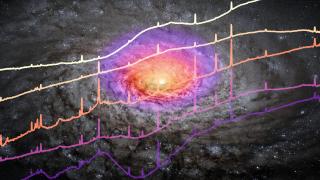Bibcode
Victoria-Ceballos, César Ivan; González-Martín, Omaira; Masegosa, Josefa; Longinotti, Anna Lia; Esparza-Arredondo, Donaji; Osorio-Clavijo, Natalia
Referencia bibliográfica
The Astrophysical Journal
Fecha de publicación:
9
2023
Revista
Número de citas
2
Número de citas referidas
2
Descripción
Above ~3 keV, the X-ray spectrum of active galactic nuclei (AGNs) is characterized by the intrinsic continuum and Compton reflection features. For type-1 AGNs, several regions may contribute to the reflection. To investigate the nature of the reflecting medium, we perform a systematic analysis of the reflector using XMM-Newton and Nuclear Spectroscopic Telescope Array observations of a sample of 22 type-1 AGNs. We create a baseline model that includes Galactic absorption and an intrinsically absorbed power law, plus a reflection model. We test a set of nine reflection models in a subsample of five objects. Based on these results, we select three models to be tested on the entire sample, accounting for distinct physical scenarios: neutral/distant reflection, ionized/relativistic reflection, and neutral/distant+ionized/relativistic reflection, namely, a hybrid model. We find that 18 sources require the reflection component to fit their spectra. Among them, 67% prefer the hybrid model. Neutral and ionized models are equally preferred by three sources. We conclude that both the neutral/distant reflector most probably associated with the inner edges of the torus and the ionized/relativistic reflector associated with the accretion disk are required to describe the reflection in type-1 AGNs.
Proyectos relacionados

Actividad Nuclear en Galaxias: una Perspectiva 3D del Núcleo y su Entorno
Nuestro proyecto puede dividirse en dos líneas principales de investigación. En primer lugar, el estudio de los vientos producidos por cuásares luminosos oscurecidos y del impacto que estos tienen en sus galaxias anfitrionas (retroalimentación del AGN). Para ello hemos obtenido observaciones en el óptico e infrarrojo cercano con el Gran Telescopio
Cristina
Ramos Almeida